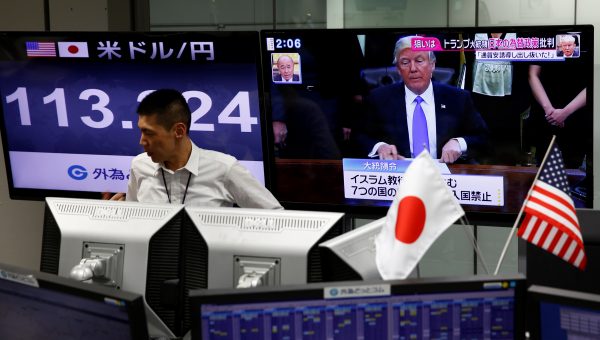The idea that emerging East Asia is economically independent of shocks in major industrial countries is sometimes called the ‘decoupling hypothesis’. It’s based on the observation that the region’s sustained high growth in the early 2000s was seemingly unaffected by the ups and downs of major advanced economies. Emerging East Asia’s economic performance has been solid despite visible slowing in most advanced economies since the global financial crisis (GFC). This performance has been underpinned by dynamic growth in China.
Emerging East Asia has achieved rapid economic expansion underpinned by strong export performance over the past few decades. The region’s high reliance on exports has been accompanied by a significant diversification of its export base: the G3 economies (the EU, Japan and the United States) collectively accounted for 29 per cent of emerging East Asia’s total exports in 2015, down from almost 50 per cent in 1990. This greater diversification in the destination of Asian exports suggests that an idiosyncratic demand shock from a single market may be mitigated by stronger growth in others.
At the same time, the share of intraregional trade in emerging East Asian economies’ total exports has risen dramatically. China, in particular, now accounts for around 30 per cent of intraregional exports. Strong growth in intraregional trade — including with China — could constitute evidence for emerging East Asia’s greater resilience to cyclical fluctuations in the major extra-regional trading partners.
But changing demand conditions in the world’s major economies — particularly the United States — still seem to represent a dominant driver behind East Asia’s export growth. Underlying this strong linkage between emerging East Asia’s growth and old industrial country growth is the nature of intra-Asian trade: the final output is often destined for markets outside the region. The growth of intraregional trade share in total emerging East Asian exports does not automatically imply its independence from an external demand shock. Emerging Asian exports remain highly sensitive to economic shocks from outside the region.
As the region’s main production base, China has been at the centre of this growing intra-industry and intraregional trade. China has recently emerged as a major importer of primary commodities, while processed intermediate and capital goods, rather than consumer goods, are leading its exports. Research has suggested that China has increasingly internalised the manufacturing input supply in the global value chain. It also exports a large and growing share of capital goods, suggesting that Chinese manufacturing production has become more sophisticated and higher value-added.
Strong trade and FDI linkages can be channels for transmitting economic shocks. As China has emerged as an important hub for intra-industry and intraregional trade and investment in Asia, it is likely that economic interdependence between China and the rest of Asia has also increased.
What are the effects of international finance on ‘decoupling’? In theory, financial integration offers many benefits, such as risk-sharing, more efficient allocation of capital for investment and enhanced macroeconomic and financial discipline. In practice tighter financial linkages also generate a higher risk of cross-border financial contagion, as illustrated by the episodes of financial crisis in 1997–98 and 2007–08.
With greater capital account openness, international portfolio assets and liabilities held by Asian economies have increased. The United States and EU also comprise the major share of emerging East Asia’s financial liabilities, which makes the region vulnerable to changes in their financial conditions. For example, during the global financial crisis, tightening credit conditions in the United States and the EU prompted repatriation of their investment funds in emerging East Asia.
The relationship between emerging East Asian and G3 equity returns strengthened after the Asian financial crisis of 1997–98 and has continued since then, weakening slightly during the GFC.
These deepening trade and financial linkages will likely influence the degree of macroeconomic interdependence. The recent trends in Asia’s global and regional trade and financial linkages suggest a stronger impact of both global and regional components in driving its business cycle.
Business cycles in emerging East Asia and the G3 became more closely correlated during times of financial crisis, with the largest spikes occurring around the Asian financial crisis between the China and the rest of EEA. Outside periods of crisis, these relationships have been much weaker.
Business cycle synchronicity might increase during crisis periods because the economies are more exposed to common shocks. But shocks that originate in one economy could also transmit to others. Our findings also support the growing importance of a regional component — especially of China — in business cycle synchronicity.
Intraregional trade and financial linkages are indeed strengthening, and China’s moving up in the global value chain may lead to a more independent source of global growth. The progress of regional trade, financial integration and regional institution building — especially in Asia — could also facilitate business cycle synchronisation more at the regional than global level. But Asia does not yet appear to be decoupling from the world economy yet. The expansion of Asia’s trade and investment links is still driven by the region’s global demand-linked production network. Emerging East Asia has become more, not less, integrated with the global economy and as a result the impact of a global shock, whether related to trade or financial markets, has become greater.
Cyn-Young Park is Director of Regional Cooperation and Integration at the Economic Research and Regional Cooperation Department, Asian Development Bank.
This article appeared in the most recent edition of the East Asia Forum Quarterly, ‘Towards Asian integration‘.

